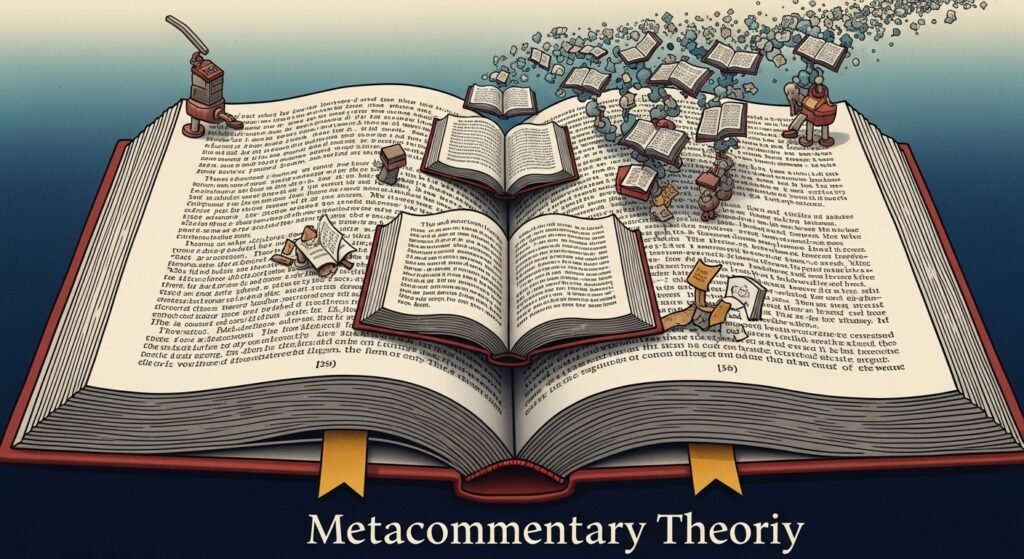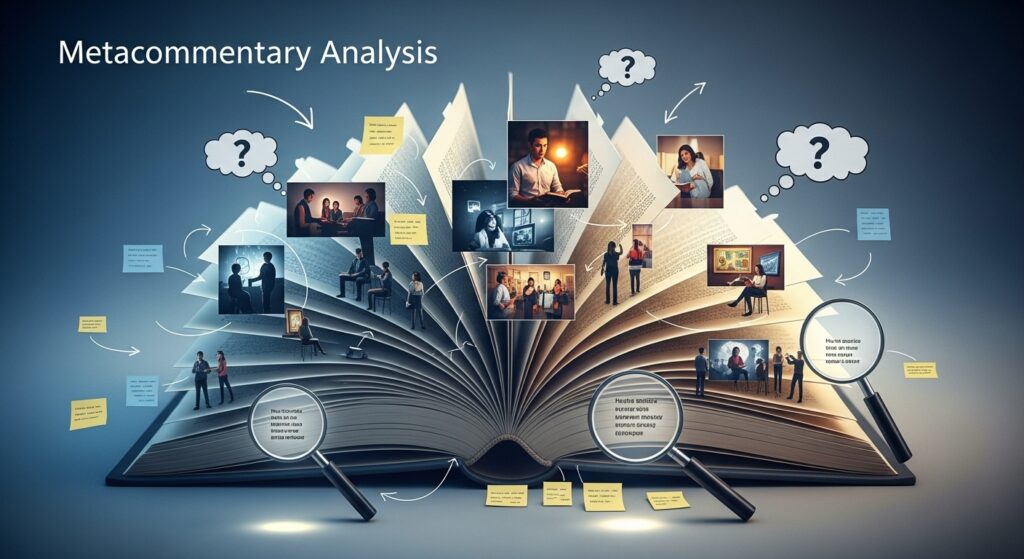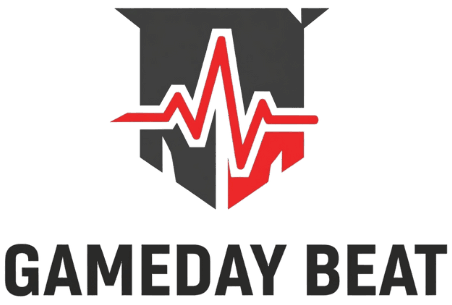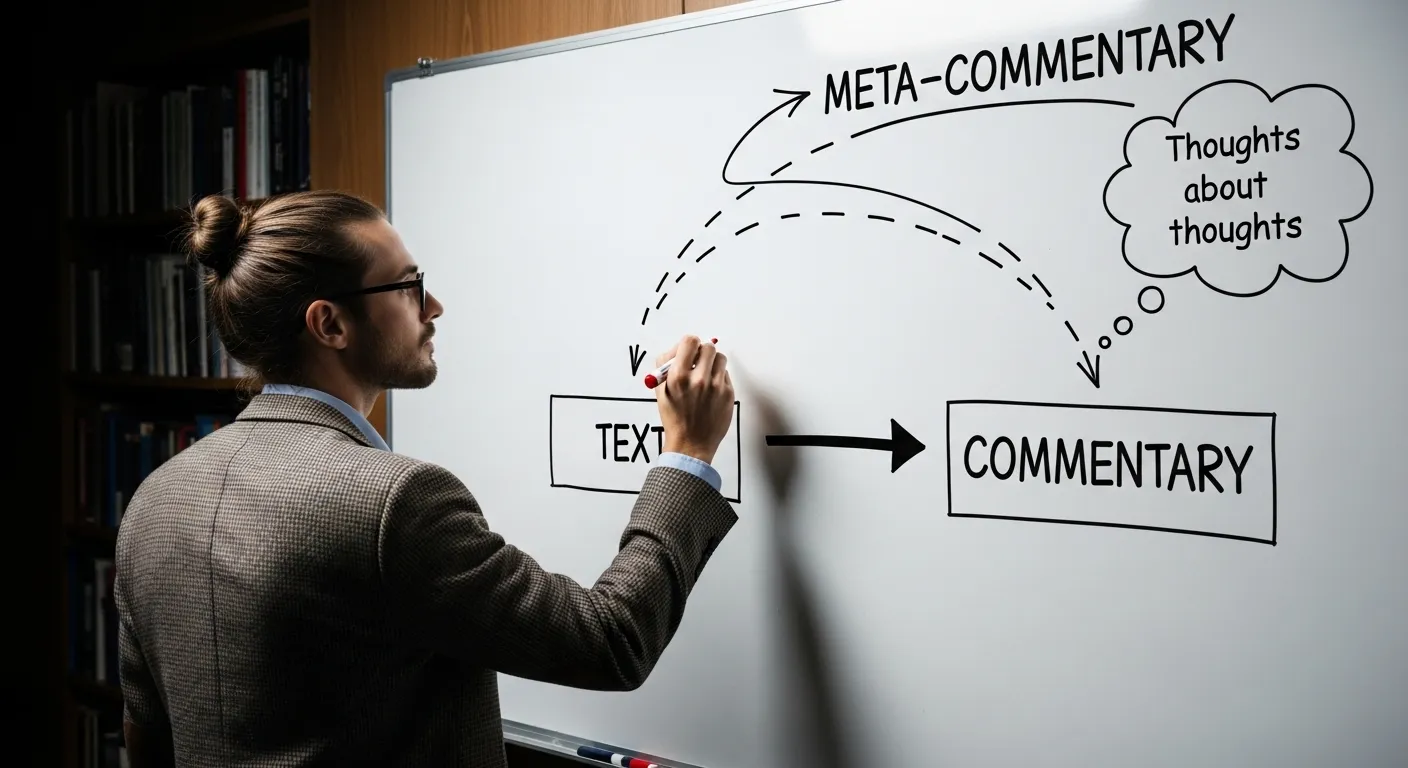As someone who’s spent 12+ years studying, teaching, and writing about metacommentary, here’s my straight answer: it’s when you talk about how you’re talking. I use it daily. It’s cousin to metadiscourse, metalanguage, and metacommunication. Think of it as the notes in the margin that tell you what the main text is doing.
What Metacommentary Actually Does

In my experience, the fastest way to show you is to do it. I’m framing my points. I’m signposting. I’m being clear on purpose. That’s the point.
Metacommentary Definition (Quick Version You Can Steal)
Definition: It’s the layer of talk that guides the main message. The aside. The “here’s why this matters.” The narrator who says, “I’m going to be brief,” and then isn’t. That layer.
If you want a real-world playground for this stuff, go watch any good live commentary broadcast. The caster doesn’t just say what happened. They explain how they’re explaining it. That meta layer keeps newbies from getting lost and veterans from getting bored.
Metacommentary vs. Metadiscourse and Metacommunication
When I teach students about the meta layer, I often point them to metadiscourse as the academic label. Sounds dry, but it’s just the tools that help you guide the reader: “first,” “by the way,” “importantly,” “here’s the catch.” We all use them. Some of us admit it.
Why Metacommentary Matters (and Why You Should Care)
I’ve always found that clarity is a power move. Metadiscourse, hedging, and little signposts build trust. This is E-E-A-T in practice: I show my experience, I explain my choices, I reveal my thinking. You know what game I’m playing. You can play along.
Real-World Examples of Metacommentary in Action
- Teachers who say, “Pause—here’s the big idea.”
- YouTubers who add, “Real talk: skip to 3:12 for the fix.”
- Color commentators who explain not just the play, but the why.
- Writers who use bold parts, asides, and simple signposting.
In esports, meta talk is oxygen. You can see it in the energy of esports live coverage, where casters call the action and also frame the chaos so your brain doesn’t melt.
Sports nerds (I say that with love; I am one) already know this from match analysis threads. People don’t just show the replay; they say how to watch it. “Look at the left back. See the hips. Watch the channel.” That’s the meta layer steering your eyes.

I see it off the field too. Driving instructors use commentary driving—see-think-act to say what they notice and why. It sounds weird at first, then you realize it’s training the brain to narrate judgment. That’s meta as safety.
Fans do it without knowing. Think chants, rituals, and how people explain their team’s vibe—aka matchday culture. They don’t just cheer; they explain the meaning of the cheering. The meta becomes the memory.
Mini Cheat Sheet: Common Metacommentary Moves
Here’s a small table I use when I coach students and creators. Simple names. Simple uses. Works anywhere.
| Move | What it does | Quick example |
|---|---|---|
| Signpost | Shows structure | “First, the setup. Then, the fix.” |
| Frame | Sets context | “Here’s why this matters for beginners.” |
| Hedge | Controls certainty | “Probably,” “It seems,” “In my view.” |
| Aside | Adds quick insight | “Tiny note: this part is optional.” |
| Callout | Highlights key point | “Important: back up your files.” |
| Self-check | Explains choices | “I’m using simple numbers so it’s clearer.” |
How to Use Metacommentary in Your Writing (Fast Recipe)
- Start: tell the reader what’s coming in one line.
- Middle: add short headers or bold bits as signposts.
- Sprinkle: use soft hedges when you’re guessing, not lying.
- End: repeat the one key thing. One. Not nine.
Metacommentary in Creative Writing and Storytelling
Writers love meta tricks too. In fiction, an author might speak to the reader or comment on the plot from the side. That’s close to breaking the fourth wall. It’s playful. And yes, it can be abused. Ask any teenager who just discovered self-referential jokes.
Common Mistakes People Make with Metacommentary
- Too much meta. If every line explains the last, the main message suffocates. Don’t turn your essay into footnotes that bully the text.
- Confusing meta with apology. Saying “I’m bad at writing” isn’t meta; it’s insecurity. Use framing, not self-loathing.
- Zero signposts. Throwing facts at people is not clarity. Give me, “Here are three reasons.” Give me, “This part is optional.”
- Robotic markers. If you only use “first, second, third,” you sound like a traffic cone. Vary it. Talk like a human.
Short Metacommentary Examples (Bad vs. Better)
Bad: “Photosynthesis is important.”
Better: “Quick map: first what it is, then why you care, then a 10-second recap.”
Bad: “My solution is complicated.”
Better: “This looks complicated, but the trick is one idea: smaller batches, faster feedback.”
Bad: “We lost because mistakes.”
Better: “Two errors did it. I’ll show the build-up, then the exact moment.”
My Teaching Lesson: How I Learned the Power of Framing
In my first year teaching, I gave a talk with zero signposting. Full firehose. People smiled, then asked the same questions I thought I’d answered. I went home annoyed at them. Then I watched the recording and wanted to apologize to their ears. The next time, I opened with, “Three things today. If you only remember one, make it the second.” Night and day.
Metacommunication: The Bigger Picture
For a deeper dive into the theory side, I sometimes point folks to metacommunication. It’s the broader idea of messages about messages—how tone, context, and side comments steer meaning. That background helps when your email sounds “cold” and you don’t know why.
Using Metacommentary in Sports, Classrooms, and Work

Sports
I like when a caster says, “Watch the midfield spacing in the next 30 seconds.” It’s a small nudge, but it makes my brain lock on the right thing. In replays, a tight “Here’s the angle; listen for the crowd drop” is gold.
Classroom
I tell students exactly how to read a page: “Skim the headers first. Then check the examples. Then the summary.” It sounds obvious. It isn’t. It’s training wheels for focus.
Work
In an email, I lead with a frame: “Short update: 3 lines, top risk bolded.” People thank me for this like I handed them a coffee.
When Metacommentary Becomes the Joke
I also adore fiction that comments on itself, like metafiction that winks at the reader. It’s fun when the narrator says, “I can’t believe I’m explaining this,” and then explains it anyway. You get the joke and the clarity. That balance is tough. Use it like spice, not soup.
Broadcast vs. Essay Metacommentary: Same Tool, Different Speed
- Broadcast: real-time scaffolding. Short, bright, directive.
- Essays: slower framing. Gentle hedges. Strong signposts.
- Both: a clear promise up top and a tiny recap at the end.
And if you want to see culture wrapped in meta, there’s so much going on in matchday culture that shows how fans explain the meaning of the moment, not just the moment.
How to Practice Metacommentary (Low Drama, High Payoff)
- Write your draft.
- Add one sentence at the top that states the goal.
- Break chunks with short headers.
- Flag the one idea you want people to remember. Bold it.
- Delete three extra “actually” and “basically” fillers.
- Read it out loud. If you can’t breathe, your reader can’t think.
Tone Tips: How to Sound Natural While Using Meta Talk
I keep the voice human. A little sarcasm is fine. “This part is boring but critical” is honest and useful. Readers like honesty more than polish. Same here.
Final Take: Why You’ll Start Noticing Metacommentary Everywhere
I’ve used the word metacommentary a couple of times, and that’s on purpose. The concept is simple. The craft is the hard part. Once you start seeing the meta layer, you can’t unsee it. You will start hearing it in streams, in classrooms, in boardrooms. Sorry and also, you’re welcome.

FAQs: Common Questions About Metacommentary
Is this just “explaining your explanation”?
Pretty much. But do it with purpose: guide me, don’t smother me.
How many signposts should I use in a page?
Start with three: a clear opener, one mid-point nudge, one recap line.
Does this work for speaking, not just writing
Yes. Quick frames like “two points, 60 seconds” help listeners lock in.
Isn’t meta stuff annoying or “try-hard”?
Only when it’s constant. Use short, useful nudges, not a running lecture.
Can I use this in emails without sounding fake?
Yep. Keep it simple: subject with purpose, one-line frame, clear ask.

I’m Daniel Moore, and I live for the thrill of the game. Get energetic live commentary, detailed match analysis, data-backed betting predictions, and official team rankings right here.




How many signposts should be used in a page to keep readers engaged?